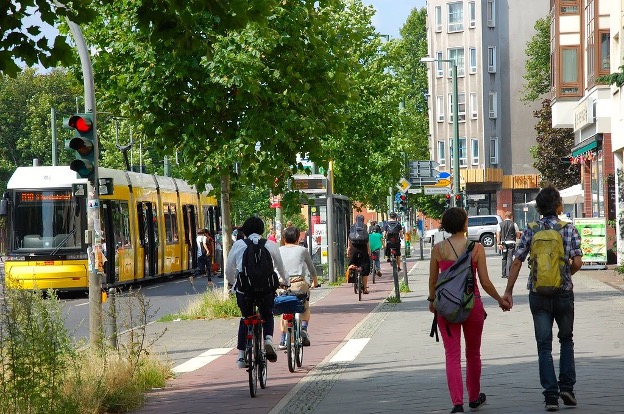
By Ximena Gonzalez, Alliance for Sustainability Intern, The University of Texas at Austin ‘23
Cities need to be redesigned for a future that includes everyone. Not only can cities be the answer in the face of climate change, resource scarcity, and population growth, but they can also be the answer to stark divisions between the affluent and the poor. There are simple solutions to more equitable cities that can be easily implemented and have almost immediate effects. However, there are also more complex solutions that might need more political power and community backing to work in the long-term.

Where Do We Go From Here?
Covid-19 has changed the way we interact with each other and our built environment. So what are some solutions to bring communities back together, encourage people to move back into the city, and promote equity and quality of life for everyone?
- Build more public spaces – These might include libraries, parks, trails, or plazas. Public spaces are natural gathering grounds for city dwellers to come and play, eat, read, or sit with their friends or their own thoughts. If public spaces have comfortable and varied seating, natural elements, and are within walking distance, they become excellent socializing areas. However, these spaces must be open and accessible to all people meaning they must be free to enter and within walking distance of every neighborhood.
- Make public transportation more accessible, more reliable, and more expansive – Public transportation should be a simple and trustworthy alternative to car travel within a city. It should be so good that no one should want to own a car. This means public transportation must be cheap, arrive on time, and have spots in all directions of the city so that every neighborhood is reached and can get into the center of the city without issue.
- Increase the minimum wage – By increasing the national minimum wage to at least $15 an hour, 17 million people would receive increased wages and another 900,000 people would be lifted out of poverty. This would improve the quality of life of so many Americans.
- Build more affordable housing – People have the right to clean, affordable housing. However, affordable housing is often built far away from commercial centers or more affluent areas, meaning lower-income people are further from their jobs and must make longer commutes. Increasing the availability of affordable housing would also help house unsheltered people.
How Easy Is It?
The short answer: It will not be very easy. The long answer: If enough communities, politicians, architects, urban planners, and activists came together to work on these solutions, they are possible. And possible is all you need when you’re working to solve complex and systemic problems.
It is important to remember that a lot of solutions might also have unforeseen consequences in the long term. For example, while the $15 wage increase would benefit a lot of people, it might also leave 1.4 million people unemployed. Another example is that making public transportation more accessible, reliable, and expansive will probably mean an increase in taxes or a change to the government’s budget.
This is why it is so important to collaborate not only with all different kinds of professionals, but also with all different kinds of community leaders, neighborhoods, ages, genders, and races. The people who live in these communities are the ones who know what’s best for them.
The Alliance for Sustainability defines sustainability “as being ecologically sound, economically viable, socially just and humane, embodying our highest values in terms of how we treat people, animals and the planet”. The future of cities needs to embody this definition because cities are where the economy, people, and nature come together. Our visions of the future and the solutions we implement must foster these ideas of sustainability and support the effortless combination of all urban aspects. Cities are for people, and those people can build better cities. That is the dream of urban living.
